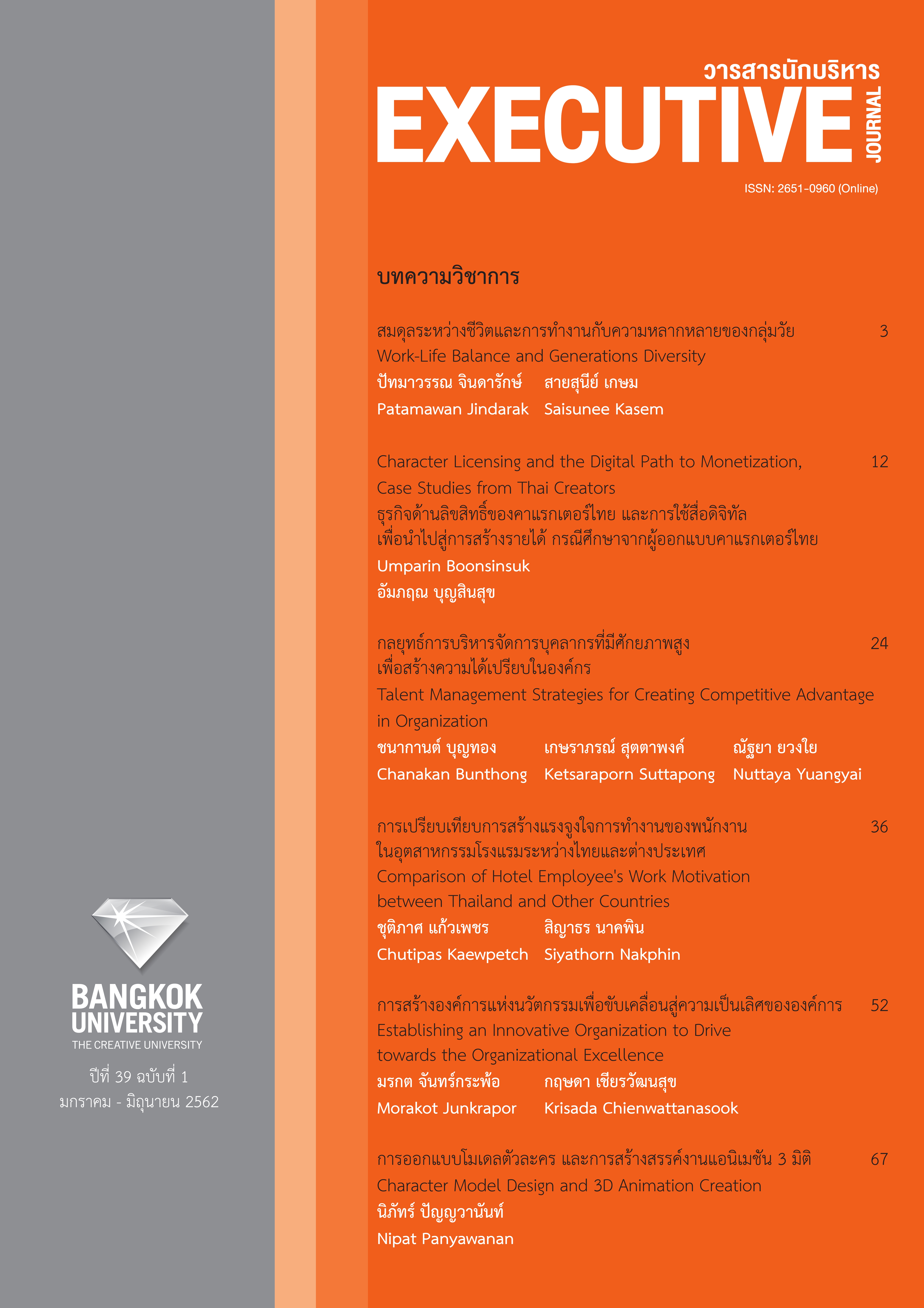Talents Development Strategies for Creating Competitive Advantage in Organization
Main Article Content
Abstract
Talent management is defined as a function within an organization that focuses on creating highly talented human resources, to provide the human capital in an organization with the necessary thinking skills and capabilities required by industry markets in order for the organization to move up to a higher position is vitally important. All organizations need highly skilled employees thus they are able to create more effective and efficient competition strategies or business strategies for themselves to accomplish their marketing goals. Therefore, this article focuses on gathering the related concepts and theories regarding skilled human development strategies such as Skill Recruitment and Selection Strategy, Skill Development Strategy and Skill Rewarding and Retention Strategy in order to investigate the advantages that organizations gain through these strategies.
Article Details
The manuscript submitted for publication must be the original version, submitted only to this particular journal with no prior acceptance for publication elsewhere in other academic journals. The manuscript must also not violate the copyright issue by means of plagiarism.
References
Auareesuksakun, A., & Chuntuk, T. (2015). Kānbō̜rihān čhatkān khon keng chœ̄ngkon yut: Patčhai samkhan sū khwām daiprīap thāngkān khǣngkhan yāng yangyư̄n [An optimal strategic talent management: Key success factors for sustainable competitive advantage]. Veridian E-Journal, 8(3), 1096-1112.
Barney, J. (1991). Firm resources and sustained competitive advantage. Journal of Management, 17(1), 99-120.
Berger, L. A., & Berger, D. R. (2004). The talent management handbook: Creating organizational. excellence by indentifying, developing, and promoting your best people. New York: McGrew-Hill.
Intharakoed, M. (2017). Inkadkānbō̜rihān čhatkān khon keng khwām thāthāi khō̜ng ʻongkō̜n [Talent management: Corporate challenge]. Business Review, 9(1), 279-290.
Jaroensook, N., Chumkaew, S., & Suttapong, K. (2015). Konlayut kānsō̜n ngān (Coaching) phư̄a sāng samatthana thī pen lœ̄t nai kān patibat ngān[Coaching strategy for creating the excellence work performance]. WMS Journal of Management, 4(2), 60-66.
Kitiarsa, N. (2015). Kānphatthanā rūpbǣp kānbō̜rihān čhatkān khon keng khō̜ng hō̜ngsamut sathāban ʻudomsưksā ʻēkkachon [Development of talent management model for library staff in private higher education institutions]. T.L.A. Bulletin, 59(1), 71-83.
Lawler, E. E., & Ulrich, D. (2008). Talent: Making people your competitive advantage. San Francisco: Jossey-Bass.
Lewis, R. E., & Heckman, R. J. (2006). Talent management: A critical review. Human Resource Management Review, 16(2), 139-154
Michaels, E., Handfield-Jones, H., & Axelrod, B. (2001). The war for talent. Boston: Harvard Business School Press.
Nantawattananukun, A., Sadangharn, P., & Ingard, A. (2015). Mō dē lakān bō̜rihān čhatkān khon keng khondī khō̜ng sathānprakō̜pkān ʻutsāhakam faifā læ ʻileksō̜nik [The talent management model in electrical and electronics industry companies]. Burapha Journal of Business Management, 4(1), 55-71.
Nimitsadikul, P., & Jadesadalug, V. (2016). Krabūankān bō̜rihān sapphayākō̜n manut khō̜ng mahāwitthayālai rātchaphat nakhō̜n pathom [The human resource management process of the Nakhon Pathom Rajabhat University]. Veridian E-Journal, 9(3), 631-652.
Noe, R. A., Hollenbeck, J, R., Gerhart, B., & Wright, P. M. (2012). Human resource management: Gaining a competitive advantage (8th ed.). New York: McGraw-Hill.
Orankjpaiboon, P. (2015). Kānphatthanā tūa bǣp kānčhatkān khon keng chœ̄ng rukkha ʻong witsawakō̜n nai ʻutsāhakam phalit hātdit [Development of strategic talent management for engineer in hard disk drive manufacturing industry] (Master’s thesis, Silpakorn University).
Pholkla, M. (2017). Kānbō̜rihān khon keng: Nǣokhit læ lak patibat [Talent management]. Journal of MCU Humannities Review, 3(1), 137-145.
Pucki, V., Tichy, N. M., & Barnett, C. K. (Eds.). (1992). Globalizing management: Creating and leading the competitive organization. New York: Wiley.
Rumpel, S., & Medcof, J. W. (2006). Total rewards: Good fit for tech workers. Research Technology Management, 49(5), 27–35.
Sadangharn, P. (2013). Kān thamrong raksā khon keng nai ʻongkān [Retaining talented people in organization]. Executive Journal, 33(3), 33-38.
Sapphayarat, C., & U-on, V. (2017). Khwāmsamphan chœ̄ng khrōngsāng khō̜ng kānbō̜rihān čhatkān khon keng thī song phon tō̜ phonlakā rō̜dam nœ̄n ngān khō̜ng ʻongkān [The structural relationship model of talent management effecting on organizational performance]. RMUTT Global Business and Economics Review, 12(1), 113-130.
Sears, D. (2003). Successful talent strategies: Achieving superior business result through market-focused staffing. New York: American Management Association.
Suphanalai, P., Kongklay, J., & Kittisakwin, C. (2017). Kān raksā khon keng dōi kānhai rāngwan [Retention to talent by using reward]. Journal of Graduate Studies Valaya Alongkorn Rajabhat University, 11(2), 241-250.
Suphanalai, P., & Siriwong, P. (2016). Kānčhatkān khon keng nai ʻongkō̜n phāk thurakit ʻēkkachon khām chāt nai prathēt Thai [Smart people management in private transnational business organizations]. Journal of Chandrakasemsarn, 22(42), 31-41.
Tantrajin, P., & Chantuk, T. (2016). Kānphatthanā læ kān thamrong raksā khon keng nai ʻongkān konkai thī samkhan nai kān khapkhlư̄an ʻongkān sū khwāmsamret [Developing and retaining talented people: The important mechanisms in running to the organization achievement] . Veridian E-Journal, Silpakorn University, 9(1), 920-931.
Tepayakul, R., & Rinthaisong, I. (2016). Khwāmmāi læ ʻongprakō̜p khō̜ng kānbō̜rihān khon keng nai ʻongkō̜n: Kān thopthūan wannakam [The meaning and the components of talent management in organizations: Literature review]. Journal of Southern Technology, 9(2), 77-84.
Walter, G. T., Stephen, A. S., & Jonathan P. D. (2010). Exploring talent management in India: The neglected role of intrinsic rewards. Journal of World Business, 45(2), 109-121.

